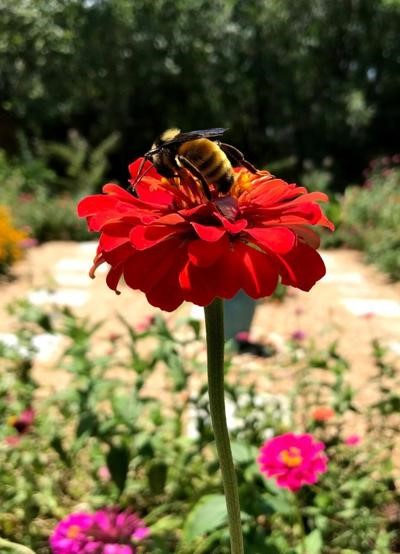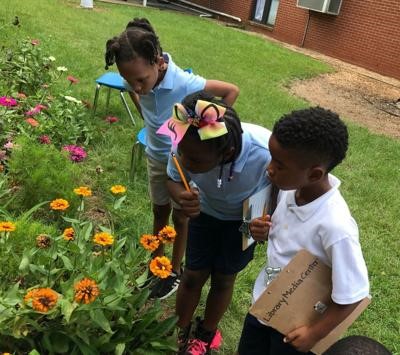Taking part in the Great Georgia Pollinator Census
• By Doug Porter Special to The Albany Herald
 • Special Photos: Karen Liebert
• Special Photos: Karen Liebert
Participants will count insects for 15 minutes on Aug. 21 and 22 as part of the Great Georgia Pollinator Census.
 • Special Photo: Karen Liebert
• Special Photo: Karen Liebert
Second-grade students — local and across the state — took part in last year’s Great Georgia Pollinator Census.
I saw a guy in Lowe’s yesterday carrying three cans of wasp spray to the checkout counter. He had a can in each hand and one under his arm. The man strode with purpose, holding the type of lethal spray that shoots out in a stream for a long-distance kill. I recognized that guy’s insect spray because I have a can at home. I have used it on the wasp nest in the ceiling of my garden shed. It is for wasps and hornets and it advertises a “20 FT jet spray.” It’s like a little fire hose. You spray it and run. That man was clearly on a mission and had a big problem if he required three cans. That’s why I noticed him.
I also noticed him because of the contrast with what I will be doing on Aug. 21 and 22 as I attempt to get as close as possible to stinging insects. I will be participating in the second annual Great Georgia Pollinator Census and attempting to identify and count all types of pollinators — including wasps — in my backyard.
Last year I was one of about 4,500 participants who documented more than 131,000 insect sightings as part of the inaugural census coordinated by the University of Georgia Cooperative Extension Service. This year’s count may look a bit different with social distancing recommendations in place, but organizers are encouraging participants to count pollinators at home while sheltering in place.
Here’s how it works. Census takers, like me, are asked to count pollinators on a favorite plant with abundant insect activity. We spend only 15 minutes each of the two days, using an observation sheet with photo ID’s of the various insects we might see.
According to the pollinator census website, the project has three goals: to gather data on pollinator insect populations, to foster and preserve good pollinator habitats, and to increase the public’s knowledge and appreciation for insects. The program is modeled after the Great Backyard Bird Count, a citizen science program run by Cornell University that asks people to count the birds they see in their backyard.
When I did the census last year, I had the hardest time distinguishing bumble bees from carpenter bees. They are both large, black bees with yellow markings, but the chart does show some distinguishing characteristics. The carpenter bee has no hair on its abdomen while the bumble bee is covered with “dense yellow and black hair.” The trick is to get close enough to see if the large, black bee has a hairy butt or a smooth, shiny hiney.
The other pollinators we try to identify included honeybees, “small bees,” (NOTE: there are more than 500 bee species reported in the state of Georgia), wasps, flies, butterflies and moths, and other insects. The chart I downloaded from the website asks the census taker to name the plant being observed and note the date, time, air temperature, and weather. It is so easy, even second-graders can do it — and last year they did.
As a media specialist in an elementary school, my wife tries to engage the students with books and activities that support their classroom curriculum. Last year, she had the first-graders, who were studying parts of the plant and planting zinnia seeds in cups. After watching the seeds sprout in the library, they transplanted them to an outdoor garden. When they returned to school in the fall as second-graders, their curriculum included the life cycles of animals, so her focus shifted to insects. Participation in the pollinator census using the same zinnias they planted last year seemed a natural progression.
Two representatives were chosen from each second-grade class and they spent 15 minutes on the Friday of the census observing and recording. They filled in their checklist and reported — both to their classmates and to the official Georgia Pollinator Census. It was a great learning experience that will not be repeated this year since the children are not in class.
As census takers, we record a variety of animals that transfer pollen, creatures that are attracted to the colorful flowers and their sweet nectar. But bees are the champion pollinators. They gather both nectar and pollen, which sticks to them while they are visiting the flowers. They then return to the hive covered in bright yellow balls of pollen, which they feed to the larvae and other members of the colony.
Commercial beekeepers travel the highways of America with hundreds of hives that provide pollination for crops from California to New England. Without bees pollinating our crops, our food supply would be in jeopardy. Small farmers also need pollinating bees and other insects to help them to farm profitably and feed the world’s population. However, since 2006 bee populations have been steadily declining due to colony collapse disorder, reduced habitat, lack of economic sustainability and climate change.
But, according to Forbes magazine, the largest threat to our nation’s honeybees is the market for honey. Prior to COVID-19, the American honey market was already declining due to imports of cheap foreign honey. Now, beekeepers are really struggling. Foreign honey impacts their cash flow, which in turn increases the risk that they will not have enough money to continue taking care of their bees.
One of the most effective ways to protect bees in America is to purchase locally produced honey. When I was director of Chehaw Park, we were pleased to partner with local beekeepers to place hives at the park. That small group of individuals has grown into the SOWEGA Beekeepers Club, and their honey is sold at the park.
On Friday and Saturday, Aug. 21 and 22, I will be parked in my backyard, peering at a zinnia flower, counting bugs. The biggest challenge is that the count lasts only 15 minutes and it focuses on one flower. With so many butterflies, bees, and other insects flitting about the garden, the temptation will be to move to a “better” flower and to count longer than just 15 minutes. If I see any wasps, I will dutifully count them. But if they return to the ceiling of my shed to build a nest, that can of long-distance wasp spray might have to come back out. My affinity for “pollinators” only goes so far.
For more information on the Great Georgia Pollinator Census visit the website at www.ggapc.org.
https://www.albanyherald.com/features/taking-part-in-the-great-georgia-pollinator-census/article_f74663ee-e089-11ea-9fa7-f3dc9f745f23.html
________________________________________________________________________________









